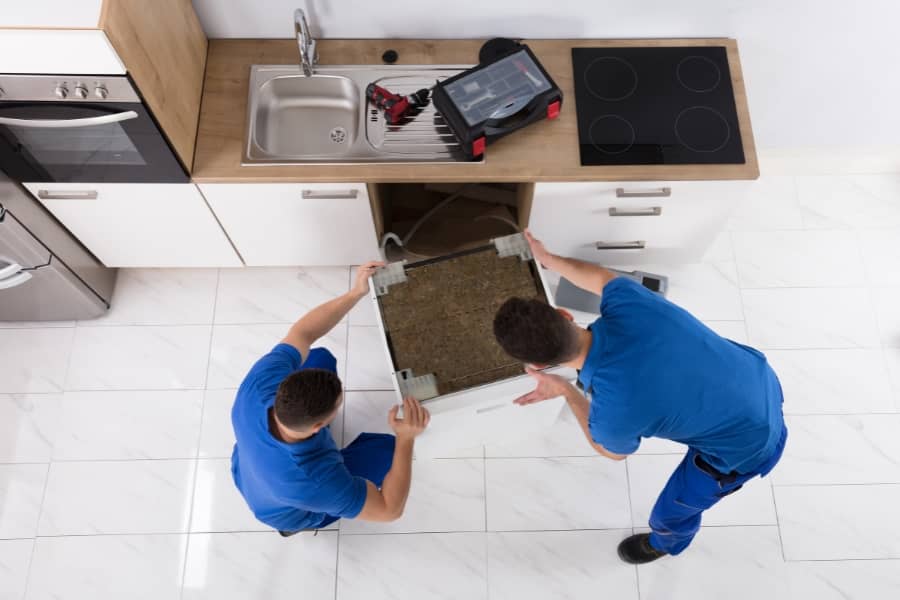
The dishwasher is becoming a non-negotiable part of a modern kitchen, but it requires care to ensure a long life. Luckily, dishwasher maintenance is one of the simplest household chores. Some regular cleaning and checking on clogged bits of food or bad smells will do the trick. At CW Service Pros we can help prevent dishwasher clogging, but there are still other maintenance rules you can follow. These few maintenance tips can keep your dishwasher running well.
1. Dishwasher Maintenance Tip: Do a Regular Deep Clean
You probably wipe down the outside of your dishwasher fairly often while cleaning the rest of the kitchen. But how often does your dishwasher maintenance include a deep clean that focuses on the inside of the dishwasher? While running the wash cycle does help clean the interior of the machine, some parts need a little extra aid from you.
Clean the Bottom of the Machine
Start by emptying your dishwasher, then take out the top and bottom racks. This will give you room to wipe down the inside of the machine. For this, grab a damp cloth and add a few drops of dish soap. Remove any accumulated food debris or residue, then use the cloth to clean the bottom and the other interior surfaces. Once you’re done, replace the racks, making sure the wheels are aligned correctly. This ensures the spray arm isn’t blocked, which can result in poorly cleaned dishes.
Clean the Drain
The dishwasher drain is located at the bottom of the unit and is where water exits the machine during the wash cycle. This means it’s also where food debris tends to accumulate. It’s important to keep the drain clear, both to facilitate the wash cycle and to prevent clogs that could result in flooding.
To clean the drain, first turn off and unplug the dishwasher. Then:
- Empty the dishwasher and remove the racks.
- Remove and clean the filter.
- Freshen the drain with a combination of baking soda and white vinegar: Tip a quarter cup of baking soda into the drain, then add half a cup of white vinegar. Wait 15 minutes for the baking soda and vinegar to react, then replace the filter, screen, and racks.
- Run the dishwasher on its hottest setting, and add an extra half-cup of vinegar to the cycle.
If you run your dishwasher daily, use this method to clean the drain every one to two months. You can get away with cleaning the drain less often if you use your dishwasher less frequently. But as an added bonus, cleaning your drain with this method will also help to keep the drain hose clean and free from debris that could cause a clog.
Dishwasher Maintenance Tip: Wipe Down the Door Seals
A very simple way to keep your dishwasher performing at its best is to wipe down the seals around the dishwasher door. Food particles often cling to these seals and can cause leaks or erosion. For this, grab your damp cloth and use that to wipe food residue from the seals.
In addition to the inside and outside of the door, be sure to clean the:
- Utensil baskets
- Gasket
- Detergent dispenser
Clean the Filter
Just like the drain in your sink, the filter in your dishwasher is meant to catch large food particles. And just like your sink drain, the dishwasher filter can’t function effectively if it’s jammed full of waste.
An important part of cleaning your dishwasher is cleaning out the filter or filters. This should be done weekly, and it’s easy! Just give them a rinse in hot water and check for any tiny food particles stuck in the mesh. Check your dishwasher manual to find out how to safely remove the filters.
Clean and Soak the Spray Arm
The spray arm has the important job of spraying soap and water onto your dishes. Keeping it clean is essential to your dishwasher performing effectively. Check the spray arm about every six months for bits of food and other build-up.
Again, refer to your owner’s manual to find out how to safely remove the spray arm. Use a toothpick to clean out the small holes in the arm. Then soak it in soapy water.
If you have hard water, you may have some scale buildup to deal with. To remove scale deposits, soak the spray arm in a solution of one part white vinegar to two parts water. Let it soak for 30 to 60 minutes, then gently scrub off any scale. Finally, rinse the arm, then wipe it dry before reattaching. For areas that have hard water and a lot of scale buildup, consider installing a descaler to your home.
Check the Dishwasher Drain Hose
The drain hose on your dishwasher links the machine to your sink or garbage disposal. It’s similar in function to the hose on a washing machine, draining the machine of water at specific points in the wash cycle. It pays to check the hose regularly, as a worn hose is at risk of bursting and potentially flooding your kitchen.
The drain hose is typically located at the rear of the dishwasher. Check your owner’s manual to find out where the hose is and how to access it. You may need to move the unit away from the wall or turn it on its side to get a good look. Inspect the hose for signs of wear, and don’t be shy about replacing it if necessary. Replacing older hoses is definitely better than hundreds or thousands to restore a flooded kitchen!
2. Dishwasher Maintenance Tip: Run the Dishwasher: Empty and Hot

Many modern dishwasher models save energy with an eco-friendly setting that reduces the temperature of the water used to wash the dishes. The dishes get just as clean, but because the water isn’t scalding, the temperature doesn’t necessarily get hot enough to kill bacteria and sanitize the inside of the machine. This can allow bacteria to build up, potentially causing unpleasant smells and possible contamination of clean dishes.
Fortunately, it’s easy to combat this: Just run your dishwasher on the hottest setting every so often. To do this, set the machine to the hottest water setting possible, and run the dishwasher empty, with nothing inside. This will help clean the interior and neutralize anything that might be growing inside. Add half a cup of vinegar for an extra kick of clean.
You should only need to do this about once every six months to maintain cleanliness.
3. Dishwasher Maintenance Tip: Scrape your Plates
You’ve probably heard you shouldn’t load dirty plates into the dishwasher. The idea of washing dishes before putting them in sounds redundant, but there is some truth to it.
Your dishwasher can handle dirty and food buildup, but sticking your plate in with spaghetti all over it is a sure path to dishwasher woes. All those food scraps will end up smeared on the bottom of the machine or stuck in the filter. At worst, it may mean a debilitating clog that requires professional help.
You don’t need to rinse the whole load of dishes, but it’s best to at least scrape the large pieces of food off the plates. Once that’s done, the dishwasher will take care of the rest.
4. Dishwasher Maintenance Tip: Use a Rinse Aid
Using a rinse aid will help your dishes dry without ugly streaks. It works by reducing the surface tension of the rinse water, so it runs off drying dishes more effectively. It’s especially useful if you have hard water, as a rinse aid can prevent hard water streaks and deposits.
There are two ways to add rinse aid to your dishwasher. One is to use a dishwasher detergent that contains a rinse aid. You can also purchase rinse aid separately if your preferred detergent doesn’t use it.

Is It Time to Replace Your Dishwasher? 4 Signs
Some problems with your dishwasher are easy to spot. For instance, if it’s making strange noises or leaking, you’ll want to call a plumber right away, before you end up with a flood. If the door doesn’t latch properly, you won’t be able to run the machine at all and should consider repairing or replacing it immediately.
But some signs of dishwasher trouble are a bit more subtle. They can sometimes indicate a minor problem, but might also be a sign that it’s time to consider getting a new dishwasher altogether.
1. Dishes Aren’t Getting Clean, or Hot
One of the most obvious signs it’s time for a new dishwasher is that your dishes aren’t getting cleaned properly. If your dishes are consistently coming out of a wash cycle with food spots still remaining, that’s a good sign there’s something wrong.
Another potential problem is if your dishes are too cool at the end of the cycle. Ideally, the load of dishes should be steaming hot when the cleaning cycle ends because the heat is what sanitizes them. If they’re not getting hot enough, the heating coil or heating element may be broken. Sometimes it is better to replace the dishwasher with a more efficient, newer unit instead of spending money trying to fix a problem with an old unit.
2. Water Isn’t Draining Properly
The inside of the dishwasher isn’t completely dry at the end of a wash cycle, but it shouldn’t have standing puddles of water at the bottom. If you notice water pooling on the bottom of the dishwasher, there may be a problem with the drain.
It could be that the drain is clogged and can be fixed by removing and cleaning it. But it could potentially be that the dishwasher pump or drain is cracked or broken—in which case either the part or the whole machine needs replacing.
3. You See Signs of Rust
Whether you notice flakes of rush inside the machine or on the floor underneath it, that’s a sign of water finding its way into places it shouldn’t be.
It might be something completely innocuous—such as flakes from a baking sheet that went in the last wash cycle—but it could also be a sign that something’s breaking down somewhere. If you notice rust without any explanation, keep your eyes peeled for any other signs of trouble. Don’t keep using a machine that is rusting from the inside out. It will end in a flood if you aren’t careful.
4.Your Dishwasher Is Getting Older
Any of the above signs can be an indication that it’s time to install a new dishwasher. But if your current machine is over 10 years old, it’s a good idea to consider a replacement.
This isn’t a hard-and-fast rule, of course. If you’ve taken care to maintain your dishwasher, it could be in great shape for 10 years and beyond. Still, upgrading may be a good move, since new models are considerably more efficient in both water and energy usage.
What’s Involved in Installing a New Dishwasher?

New appliances are a financial investment. A new dishwasher costs about $400 for a basic model, up to over $3,000 for a high-end model with the latest features. Luckily, while new appliances mean making an up-front investment, they do pay for themselves over time.
While you’ll pay several hundred dollars for a new dishwasher, you could save money over time if your new appliance is more energy-efficient and water-efficient than your current model. Opting for an Energy Star dishwasher, for instance, means your new model will cost around $35 a year to run and could save almost 3,800 gallons of water over the life of the machine!
To install a new dishwasher, you’ll need to make the following connections:
- A power connection. A new dishwater installation needs its own dedicated power circuit. That can be either a standard plug-in appliance cord or a hardwired connection that feeds directly to the machine. There are also regulations for cord length and other specs, so make sure to check this out if you decide to do the work yourself.
- A water connection. This part requires a braided steel water supply tube to connect the dishwasher to the water supply pipe, plus a brass elbow-shaped fitting called a dishwasher 90. Both components are usually included in your dishwasher connection kit.
- Drain hose connection. The drain hose on the dishwasher connects to the drain trap under your kitchen sink. There’s more than one way to do this, but in all cases, make sure the drain line from the dishwasher does not run downhill and into the sink trap. If the sink stops up, you do not want dirty water to go into the dishwasher and onto your clean dishes.
Call a Plumber for Help!
As with any DIY job, it’s always best to call in a professional if you’re not confident you can complete the work yourself. Most of the work needed to install a new dishwasher requires getting down on the floor, so if this is physically difficult for you, it’s definitely a good idea to call a professional to do the work.
If you want to hardwire your dishwasher, you need to wire an electrical connection. This in particular should only be attempted if you have experience with electrical work. Otherwise, call your local plumber for help!
Need Help With Your Dishwasher? CW Service Pros Is Here for You
In a busy home, a working dishwasher is an essential part of keeping the household running smoothly. Follow these maintenance tips! A little regular dishwasher maintenance goes a long way towards keeping it in good shape over its lifetime. Sometimes, of course, you need professional help. Whether you need dishwasher maintenance, to replace an existing dishwasher, to install a new one and remove the old dishwasher during a kitchen remodel, or any other plumbing need, CW Service Pros has you covered.

















